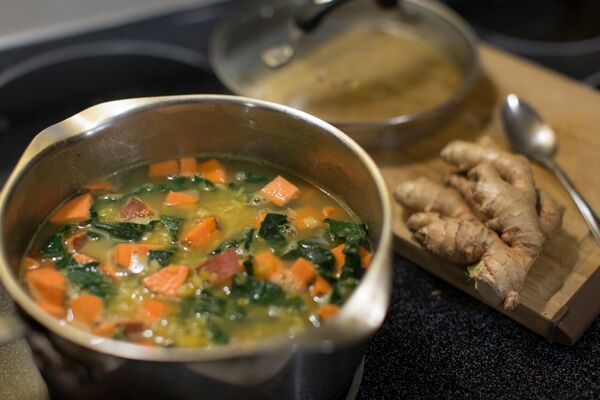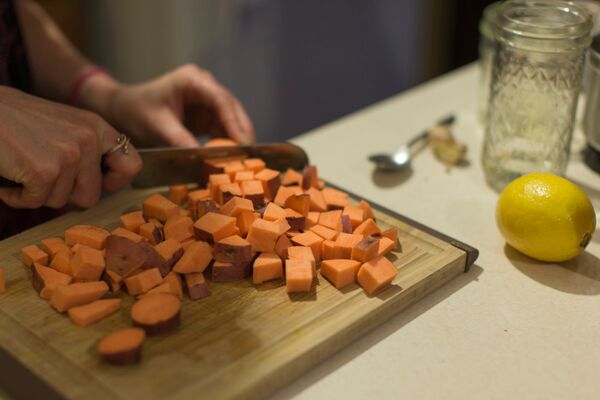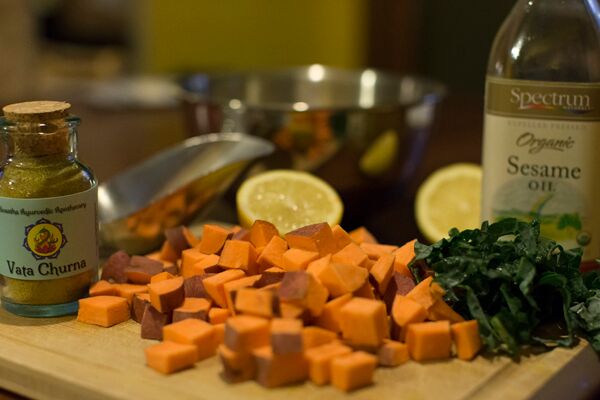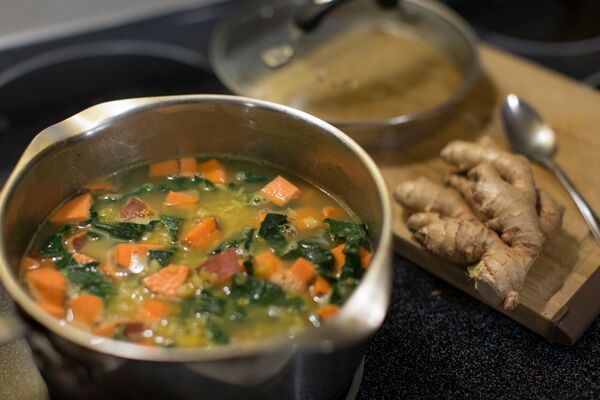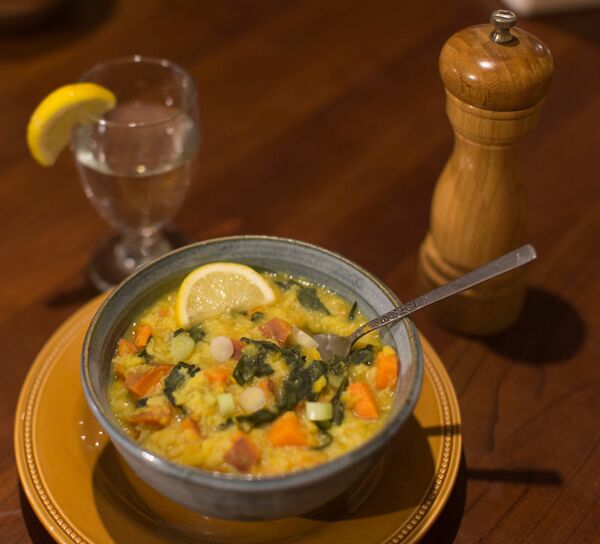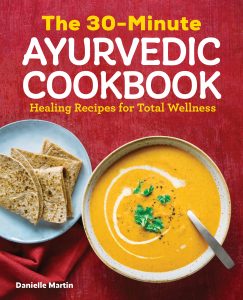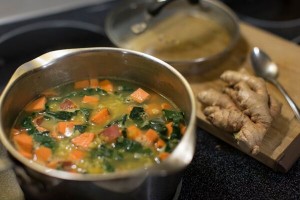 Kitchari is an Ayurvedic dish that traditionally consists of basmati rice, split mung beans (aka mung dal), Indian spices, and a variety of vegetables. Although this is a very simple meal, it can be quite versatile depending on the ingredients used. There are cleansing kitchari recipes for times of detoxification, rejuvenating kitchari recipes for times of building strength, kitchari recipes for specific doshic imbalances, and kitchari recipes for specific seasons. It is endless really! One thing they all have in common is that they are well-cooked, making them easy to digest, highly nutritious, and profoundly nourishing.
Kitchari is an Ayurvedic dish that traditionally consists of basmati rice, split mung beans (aka mung dal), Indian spices, and a variety of vegetables. Although this is a very simple meal, it can be quite versatile depending on the ingredients used. There are cleansing kitchari recipes for times of detoxification, rejuvenating kitchari recipes for times of building strength, kitchari recipes for specific doshic imbalances, and kitchari recipes for specific seasons. It is endless really! One thing they all have in common is that they are well-cooked, making them easy to digest, highly nutritious, and profoundly nourishing.
This particular kitchari recipe is specific for those of a Vata body-type or those having a Vata imbalance (e.g. constipation, gas, anxiety, worry, sleep issues, restless thoughts, and excessive dryness). Being that fall is considered the season of Vata, it is also perfect for this time of year, helping one to stay grounded and centered during this time of transition.
The sweet potato and beets in this recipe are perfect for Vata, being of an earthy-rooty nature. The warming qualities of the fresh ginger, fresh lemon juice, and Vata-friendly spices help to increase a weak digestive fire while preventing Vata digestive issues such as gas, bloating, cramping, and constipation. Using bone broth as a base is an amazing way to get a wide variety of essential, easy-to-absorb, rejuvenating nutrients. Bone broth is also extremely healing in many Vata disorders and it is great for lubricating the body both inside and out.
Taking this meal during times of chaos, ungroundedness, depletion, or low energy will help one to become more centered, increasing focus, boosting energy, and strengthening the body. Always remember that Vata types need a routine in their life and this is especially true when it comes to our eating habits. In general, Vata individuals need three warm, nourishing meals daily and this recipe is a great place to start!
Vata-Reducing Kitchari Recipe
Click here for a printable copy of this recipe.
- Doshic effect: Vata ↓,Pitta ↓, Kapha ↑
- Serves: 4 to 6
- Prep Time: 10 minutes
- Cook Time: 35 minutes
- Gluten-free
- Vegan or Vegetarian (with modifications)
Materials
- Large saucepan
- Cutting board and knife
- Grater for ginger (optional but recommended)
- Measuring cups
Ingredients
- 1/2 teaspoon cumin seeds, whole
- 1/2 teaspoon brown mustard seeds, whole
- 1/4 teaspoon freshly ground black pepper
- 1 teaspoon Vata Churna
- 2 tablespoons shredded coconut
- 1/8 teaspoon cayenne pepper
- 7 cups bone, chicken, or vegetable broth (substitute with water)
- 1/4 cup minced onion
- 2 tablespoons finely minced fresh ginger
- 2 tablespoons sesame oil
- 2 cinnamon sticks
- 1 cup mung dal
- 1 medium carrot, thinly sliced
- 1/2 cup chopped sweet potato
- 1/3 cup chopped beet
- 1/2 cup chopped cauliflower
- 2 cups baby spinach leaves, chopped
- 1 cup basmati rice
- 1 lemon, juiced
- 1/2 teaspoon pink Himalayan salt or mineral salt
- Ghee, for individual servings
- Chopped cilantro, for garnish
- Shredded coconut, for garnish
Click here for a printable copy of this recipe.
Directions
1. Measure the spices and the water to have ready. Mince the onion and ginger.
2. Warm the sesame oil over medium heat in a large soup pot. Once hot, add in the onion, cumin seeds, brown mustard seeds, and black pepper. Sauté for 2 minutes, stirring frequently. Add in the Vata Churna, ginger, coconut, and cayenne. Sauté for 30 seconds, stirring constantly.
3. Add in the broth (or water) and cinnamon sticks. Increase the heat to high, cover the pan, and bring it to a boil.
4. Once boiling, reduce the heat to medium and add in the mung dal. Stir well and cover the pan, leaving a large crack in the lid. Cook for 10 minutes stirring around half way.
5. As the beans are cooking, begin to chop up the carrot, sweet potato, beet, and cauliflower into small, bite size pieces.
6. After 10 minutes, add in the rice, carrot, sweet potato, beet, and cauliflower to the pot. Stir well and place back the lid keeping a large crack. Cook over medium heat for 10 minutes, stirring every 3 to 4 minutes.
7. While waiting, chop the spinach into thin slices.
8. After 10 minutes, add in the spinach, reduce the heat to low, cover the pan completely, and cook for 5 minutes. Stir every 1 to 2 minutes to avoid the kitchari from sticking to the bottom of the pan.
9. Turn off the heat but leave the pan on the hot burner. Add in the fresh lemon juice and salt. Stir well and blend all of the ingredients together evenly. Cover the pan and let it sit for a few minutes to allow the flavors to harmonize.
10. Serve into individual bowls. For added Vata-reducing effects, add 1 teaspoon of ghee to each serving and garnish generously with cilantro and coconut. Additional lemon juice, salt, and pepper can be added if needed.
11. Kitchari is best the first day, however, it will keep for up to 3 to 5 days in the refrigerator. Reheat over a low heat and add in 1/4 cup of water, 1 teaspoon of ghee, coconut, cilantro, and a dash of salt and pepper with each serving.
Click here for a printable copy of this recipe.
Ayurvedic tip: This recipe tends to be best during the fall and winter due to the grounding root veggies that are used. However, you can sooth your Vata throughout the spring and summer by replacing the sweet potato and beets with zucchini and yellow squash, making it seasonal and still equally as balancing for your Vata.
Find Your Kitchari Necessities Here!
Discover more healing recipes with my 30-Minute Ayurvedic Cookbook!

